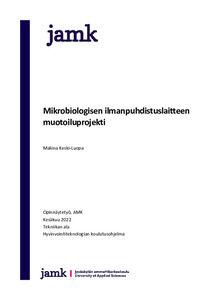Mikrobiologisen ilmanpuhdistuslaitteen muotoiluprojekti
Keski-Luopa, Maliina (2022)
Keski-Luopa, Maliina
2022
All rights reserved. This publication is copyrighted. You may download, display and print it for Your own personal use. Commercial use is prohibited.
Julkaisun pysyvä osoite on
https://urn.fi/URN:NBN:fi:amk-2022061017276
https://urn.fi/URN:NBN:fi:amk-2022061017276
Tiivistelmä
Toimeksiantajana oli terveysteknologiaan keskittynyt yritys, joka on suuntautunut luomaan tuotevalikoimaa koti- ja toimistokäyttöön sopivista ilmanpuhdistusjärjestelmistä, joissa on luonnollinen suodatin. Mikrobiologisen ilmanpuhdistuslaitteen muotoiluprojektissa suunniteltiin muoto luonnosvaiheessa olevalle laitteelle. Laitteen muotoilussa huomioitiin teollisen muotoilun, skandinaavisen muotoilun, antropometrisen muotoilun, huonekalujen tilantarpeen, ekologisen muotoilun ja käyttäjäkeskeisen suunnittelun näkökulmia. Näitä hyödynnettiin, kun suunniteltiin ilmanpuhdistuslaitteen vaatimuksia, materiaaleja, mittoja, ekologisuutta ja tuotekonseptia. Lisäksi näiden perusteella luotiin mikrobiologiselle ilmanpuhdistuslaitteelle ulkonäköön ja käytettävyyteen liittyvät vaatimukset, sekä toimiva ja esteettinen ulkonäkö.
Vaatimusten pohjalta saavutettiin luonnos tuotteesta, joka koostuu kolmesta toiminnallisesta osasta, jotka ovat jakkaraosa, laturi ja suodatin. Tuoteluonnos toimii sivupöytänä, istuimena, sekä tunnelmavalaisimena ja se myös ottaa aurinkopaneelien avulla talteen valoenergiaa, jonka muuttaa käyttösähköksi itselleen. Tuoteluonnoksen kiinteät ja vaihdettavat osat ovat materiaaleiltaan pitkälti kiertotalouden mukaisia ja sen ajatusmallia noudattavia. Kiertotalous huomioitiin myös tuoteluonnoksen elinkaaren eri vaiheissa.
Tuoteluonnosta voidaan hyödyntää tuotteen tarkempaan tekniseen jatkosuunnitteluun. Tuotekehitykseen liittyvien jatkotutkimustarpeiden arvioitiin eniten kohdentuvan tulo- ja poistoilma-aukkojen teknisiin ominaisuuksiin, biomuovien kestävyyden testaukseen veden kanssa, sekä laitteen käyttöliittymän käyttäjäystävällisyyteen. Näiden ominaisuuksien onnistunut testaus voitaisiin tulevaisuudessa toteuttaa parhaiten valmiin koekappaleen käyttöominaisuuksia ja toimivuutta tutkimalla.
Tutkimus toteutettiin laadullisena tutkimuksena. Pohjatietona käytettiin yrityksen antamaa tietoa mikro-biologisesta ilmanpuhdistuslaitteesta, sekä kirjallisuudesta ja muista dokumenteista, kuten standardeista löytynyttä aineistoa. Tuotesuunnittelussa hyödynnettiin benchmark- ja design thinking -tekniikoita. The client was a health technology company. The company has focused on creating air purifier devises with natural filters that are suitable for home and office use. In the design project of the microbiological air purification device, the shape of the device in the draft stage was designed. The design of the device considered aspects of industrial design, Scandinavian design, anthropometric design, space requirements for furniture and ecological design and user-centered design. These were utilized in the design of air purifier requirements, materials, dimensions, ecology, and product concept. In addition, these were used to create requirements for the microbiological air purification device in terms of appearance and usability, as well as a functional and aesthetic appearance.
Based on the requirements, a sketch of the product was obtained, which consists of three functional parts, which are the stool part, the charger, and the filter. The draft product acts as a side table, seat, mood light and uses solar panels to capture light energy, which it converts into power for itself. The fixed and replaceable parts of the product design are largely in line with the circular economy and follow its idea. The circular economy was also considered at different stages of the product life cycle.
The product design can be used for more detailed technical design of the product. The needs for further research related to product development were estimated to focus most on the technical properties of the supply and exhaust air openings, testing the durability of bioplastics with water, and the user-friendliness of the device's user interface. Successful testing of these properties could best be achieved in the future by examining the performance and functionality of the finished specimen.
The study was conducted as a qualitative study. The information provided by the company on the microbiological air purification device, as well as material found in the literature and other documents, such as standards, was used as basic information. Benchmarking and design thinking techniques were utilized in product design.
Vaatimusten pohjalta saavutettiin luonnos tuotteesta, joka koostuu kolmesta toiminnallisesta osasta, jotka ovat jakkaraosa, laturi ja suodatin. Tuoteluonnos toimii sivupöytänä, istuimena, sekä tunnelmavalaisimena ja se myös ottaa aurinkopaneelien avulla talteen valoenergiaa, jonka muuttaa käyttösähköksi itselleen. Tuoteluonnoksen kiinteät ja vaihdettavat osat ovat materiaaleiltaan pitkälti kiertotalouden mukaisia ja sen ajatusmallia noudattavia. Kiertotalous huomioitiin myös tuoteluonnoksen elinkaaren eri vaiheissa.
Tuoteluonnosta voidaan hyödyntää tuotteen tarkempaan tekniseen jatkosuunnitteluun. Tuotekehitykseen liittyvien jatkotutkimustarpeiden arvioitiin eniten kohdentuvan tulo- ja poistoilma-aukkojen teknisiin ominaisuuksiin, biomuovien kestävyyden testaukseen veden kanssa, sekä laitteen käyttöliittymän käyttäjäystävällisyyteen. Näiden ominaisuuksien onnistunut testaus voitaisiin tulevaisuudessa toteuttaa parhaiten valmiin koekappaleen käyttöominaisuuksia ja toimivuutta tutkimalla.
Tutkimus toteutettiin laadullisena tutkimuksena. Pohjatietona käytettiin yrityksen antamaa tietoa mikro-biologisesta ilmanpuhdistuslaitteesta, sekä kirjallisuudesta ja muista dokumenteista, kuten standardeista löytynyttä aineistoa. Tuotesuunnittelussa hyödynnettiin benchmark- ja design thinking -tekniikoita.
Based on the requirements, a sketch of the product was obtained, which consists of three functional parts, which are the stool part, the charger, and the filter. The draft product acts as a side table, seat, mood light and uses solar panels to capture light energy, which it converts into power for itself. The fixed and replaceable parts of the product design are largely in line with the circular economy and follow its idea. The circular economy was also considered at different stages of the product life cycle.
The product design can be used for more detailed technical design of the product. The needs for further research related to product development were estimated to focus most on the technical properties of the supply and exhaust air openings, testing the durability of bioplastics with water, and the user-friendliness of the device's user interface. Successful testing of these properties could best be achieved in the future by examining the performance and functionality of the finished specimen.
The study was conducted as a qualitative study. The information provided by the company on the microbiological air purification device, as well as material found in the literature and other documents, such as standards, was used as basic information. Benchmarking and design thinking techniques were utilized in product design.
